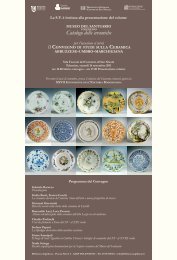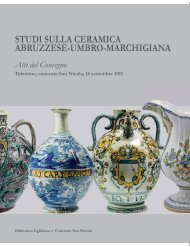Le maioliche rinascimentali nelle collezioni della ... - Claudio Paolinelli
Le maioliche rinascimentali nelle collezioni della ... - Claudio Paolinelli
Le maioliche rinascimentali nelle collezioni della ... - Claudio Paolinelli
Create successful ePaper yourself
Turn your PDF publications into a flip-book with our unique Google optimized e-Paper software.
Flattish plate without well. Tin-glazed front and back. The reverse is<br />
decorated on the white glaze with blue rings round a central spiral.<br />
Diam: 24 cm.<br />
The plate is fragmentary and incomplete, with extensive restorations<br />
and completion of the painting on the front. The restoration was carried<br />
out by Anna Grossi 17 . The original parts are the whole of the centre and<br />
the greater part of the left hand side; almost the whole of the right hand<br />
side is restoration.<br />
Provenance: Said to have been found in the Province of Mantua;<br />
private collection, Province of Mantua; Cesare Ugolini; Fabrizio Frizzi<br />
Baccioni.<br />
Bibliography: none.<br />
424<br />
Notes<br />
1 Blindfolded Cupid represents the blind, irrational nature of physical<br />
love (Panofsky 1975, pp. 135-183). Blindfolded love occurs on some<br />
maiolica similar to this: Rackham 1940, nos 524-526, 533; McNab<br />
1995 p. 521.<br />
2 Poole 1995, no. 364, as “perhaps Castel Durante or elsewhere in the<br />
Marches”.<br />
3 Ravanelli Guidotti notes (Barbe and Ravanelli Guidotti 2006, no. 1),<br />
with respect to a lustred Gubbio plate dated 1519 at the Petit Palais,<br />
Paris, influence from potters of Castel Durante and the likely use of a<br />
woodcut source for these figures of putti or cupids.<br />
4 Fuchs 1973, no. 274. Fiocco and Gherardi 2004E, pp. 210-213, note<br />
that in these years grotesque decoration with large putti was a characteristic<br />
of Gubbio production, and is not necessarily to be considered a<br />
specifically Castel Durante style, as as often been supposed following the<br />
studies of Rackham (1928-1929).<br />
5 Rasmussen 1989, no. 62.<br />
6 Rackham 1928-1929; and for the more recent bibliography, Wilson<br />
2004, pp. 203-204.<br />
7 Fiocco and Gherardi 1997, pp. 18-19.<br />
8 Ermeti 1997 does not in her careful account of finds from Castel<br />
Durante mention material with this sort of decoration.<br />
9 Ciaroni 2004, fig. 120.<br />
10 Giannatiempo Lopez 1997, no. 30: a fragmentary plate found in the<br />
vaults of the Sala del Trono in the Ducal Palace in Urbino with similarities<br />
to the present plate. Though the colouring of the plate from<br />
Urbino is brighter and the execution more rapid, the same decorative<br />
scheme is used, with a bound cupid in the centre, flanked by two<br />
breastplates on a strong blue ground.<br />
11 Fano saw a notable growth in ceramic production in the sixteenth<br />
century. The proximity of the Duchy of Urbino generated a continuous<br />
“osmosis” of potters between adjoining districts. In the stores of the<br />
Museo Civico (inv. C444) is a fragment of a plate with a rim decorated<br />
with trophies on a dark blue ground and with ribbons filling the spaces;<br />
compare <strong>Paolinelli</strong> 2003.<br />
12 Balzani and Regni 2002B.<br />
13 Ciaroni 2004, pp. 92-95.<br />
14 Wilson 2005, p. 15. For further comparisons with fragments found at<br />
Pesaro, see Piccioli 2000.<br />
15 Among villas linked to the Gonzagas are the the Villa di Bosco <strong>della</strong><br />
Fontana at Marmirolo and the Villa Gherardina at Monteggiana.<br />
16 Ciaroni 2004, pp. 49-56.<br />
17 We are grateful to Anna Grossi for her kind collaboration.








